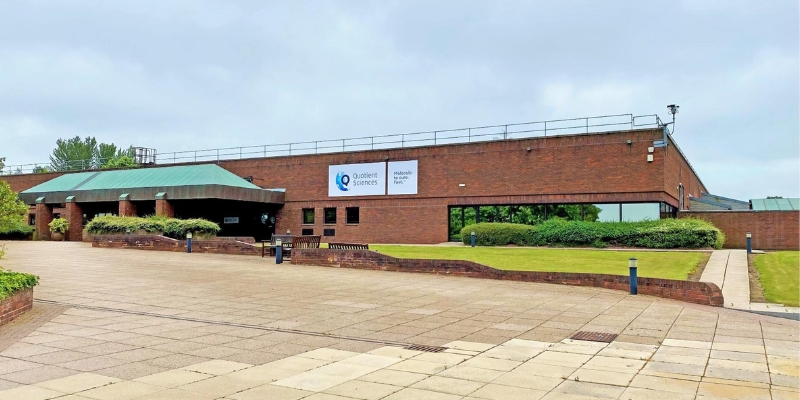In February 2021, Quotient Sciences acquired the contract development and manufacturing organization (CDMO) Arcinova, based in the north-east of England and now known as Quotient Sciences - Alnwick. In this spotlight, we talked to Gareth Jenkins, our Science & Technology Director, to find out a little more about his background and get an introduction to the expertise at the Alnwick site.
Tell us a bit about yourself, your background, and what led you to join the business?
I have worked in the pharmaceutical industry for over 25 years. My career in the sciences began at Imperial College London, where I received a degree in organic chemistry and completed my PhD on biotransformations catalyzed by Pseudomonas putida. Following a post-doctoral fellowship, I went on to work for several start-ups over the years, which introduced me to Good Manufacturing Practice (GMP) manufacturing and kilo scale-up of drug substance.
Of course, at start-ups you wear many hats, so I was able to pick up different skills moving from bench scientist to project management and into business development, which helped me understand all facets of a commercial pharmaceutical business. I’ve also worked in the drug discovery and medicinal chemistry outsourcing space, where I built strategic relationships with companies like De Novo Pharmaceuticals who offered in-silico drug design. Together, we created and launched one of the first G protein-coupled receptor (GPCR) targeted set of screening compounds based on pharmacophore modeling as, at the time, very few crystal structures were available for more traditional, rational drug design approaches.
I then moved on to head up a not-for-profit consultancy business. We worked with a variety of process groups to provide knowledge management tools to help map out process understanding, identify the gaps, and prioritize further development effort. One of the very first projects I took on was to come to a small pharmaceutical development site in Alnwick, which later became Arcinova, to do some technical due diligence. Having given some advice on how to expand the site's drug substance capabilities, a couple of years later Arcinova then persuaded me to relocate my family and join the team to ‘help make it happen’.
How has this site served the pharmaceutical industry since its inception?
Radiolabeling
The Alnwick site has produced radiolabeled drug substances since the opening of the facility in the early 1980s and has worked on the radiochemistry of over 500 molecules. Over the last 5 years, we have grown the team significantly, teaching them the skills of radiolabeling chemistry and expanding our GMP capacity. Our wealth of experience has really helped our clients by providing expert advice on where best to put the 14C label into their molecule, considering both the metabolic stability of the location with the complexity and cost of the radiosynthesis route.
Bioanalysis
The bioanalysis team at Alnwick has developed and validated over 400 bioanalytical assays supporting both pre-clinical and clinical samples. We have invested significantly in state-of-the-art mass spectrometry as our main analytical detector, as this equipment has incredible sensitivity and specificity. More recently, the team helped to develop assays for copper and molybdenum as part of the development of a treatment for Wilson’s disease and has now developed a number of other assays across the periodic table of the elements. High-resolution mass spectrometry has also helped our clients understand the pharmacokinetics of mixtures of isoforms of insulin.
Drug substance
Until becoming Arcinova, the Alnwick site was focused on pre-clinical toxicology and early-phase formulation development, with no drug substance chemistry. Part of the Arcinova strategy was to establish drug substance process research and development (PR&D) and kilo-scale GMP manufacturing, and combine this with the site’s existing expertise in molecule characterization, formulation development, and bioanalysis to help clients get molecules to patients faster.
What differentiation/specialisms does the site offer?
Flow technology
As we’ve grown over the last 5 years, we’ve recruited some very talented colleagues with experience in the most recent developments in science and technology. For example, as we grew our drug substance team, we recruited PR&D chemists with pilot plant and product experience and chemists with skills in physico-organic chemistry and modeling. We secured a UK government grant to fund our FlowInova™ project, which has helped us to invest in smarter, data-driven approaches to PR&D. This helps our clients by building a process model of the chemistry, which we use to design the best equipment configuration for scale-up to kilo scale – this can be batch or continuous technology, based on the needs of the chemistry. This data-driven approach to development can be found right across the site. We have a broad and deep range of analytical equipment, which we use to fully characterize the drugs we are developing. This helps to ensure that all facets of drug development – from drug substance, formulation development, drug product, and bioanalysis – are integrated seamlessly together.
What does the introduction of the state-of-the-art Alnwick facility offer Quotient Sciences customers?
This is the exciting bit. Together, there are so many opportunities for science and agility to integrate and combine. As a drug development and manufacturing accelerator, we can cut right across the artificial silos that pervade the pharmaceutical industry.
The immediate focus following the acquisition was to look at "How can we fully integrate our capabilities for the benefit of customers?".
Drug Substance and Drug Product Integration
This will provide clients with a seamless program of work that spans drug substance manufacturing and drug product development, in order to shorten timelines to clinical development. The customer will have the opportunity to work with a single program manager, who will coordinate and manage the project activities across Quotient Sciences sites and be the main point of contact.
We believe an early development program that integrates drug substance and drug product activities will deliver multiple benefits for our customers, including:
- Ease of contracting, project management, and communication
- More rounded scientific/development thinking on how drug substance attributes will affect downstream drug product and clinical outcomes
- Better management of critical path activities, time savings, and greater program flexibility and scheduling (mitigating delay fees with separate providers)
- More efficient synthesis/use of drug substance during the transition from pre-clinical to clinical development
- Ease of knowledge transfer between drug substance and drug product activities (e.g. analytical methods)
- Improved management of analytical reference standards
- Avoidance of shipping drug substance to a separate depot or CDMO provider
Integrated Candidate Selection Programs
We are excited about the potential synergies, and we will share more news in the months ahead on how exactly our complementary capabilities can be integrated to deliver customer benefits.
The plan is to provide a holistic scientific offering to help customers select and characterize the optimal molecules and formulations for development. A seamless program of work will bridge molecules from candidate selection, through pre-clinical, and into initial clinical development, bringing together all of the scientific disciplines and activities in a coordinated way. For example:
- Drug substance route scouting and synthesis
- Salt and polymorph screening
- Pre-formulation assessment and toxicology formulations
- Solubility and permeability assays
- Developability Classification System (DCS) assignment
- Physiologically based pharmacokinetic (PBPK) modeling and simulation
- In-vitro metabolism assessment
- Regulatory guidance
- Clinical formulation development
- First-in-human drug product
At present, there are dozens of service providers all playing a part in different pieces of this jigsaw puzzle. Quotient Sciences intends to launch a service that brings everything together in a scientifically rich manner, with chemists, biopharma/drug metabolism and pharmacokinetics (DMPK) scientists, and drug product scientists all working together within one global organization, with the overall goal being to get molecules to patients faster.

